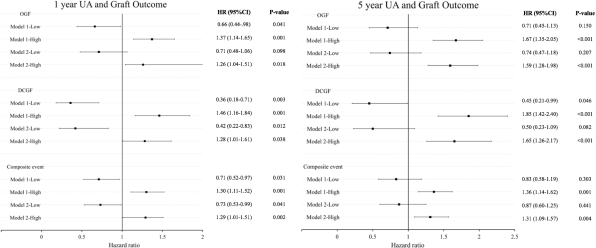Lower Uric Acid Level after Kidney Transplantation Impact on Better Long-Term Allograft Outcomes
D. Kim,1 H. Choi,2 Y. Jung,1 J. Lee,1 J. Lee,1 J. Lee,1 K. Huh,1 M. Kim,1 B. Kim,2 Y. Kim.1
1Transplantation Surgery, Yonsei University Health System, Seoul, Korea
2Nephrology, Yonsei University Health System, Seoul, Korea.
Meeting: 2018 American Transplant Congress
Abstract number: A193
Keywords: Graft survival, Kidney transplantation, Metabolic disease
Session Information
Session Name: Poster Session A: Kidney: Cardiovascular and Metabolic
Session Type: Poster Session
Date: Saturday, June 2, 2018
Session Time: 5:30pm-7:30pm
 Presentation Time: 5:30pm-7:30pm
Presentation Time: 5:30pm-7:30pm
Location: Hall 4EF
Background
It has been on debate that hyperuricemia was an independent risk factor for poor prognosis in kidney transplantation. Considering the link of UA with diabetes, metabolic syndrome, hypertension and cardiovascular disease, it might be beneficial for graft function to maintain lower level of UA in post-transplant period. The present study aimed to investigate whether average lower UA levels during the first year and five years after kidney transplantation (KT) have a positive effect on long-term renal allograft outcomes in a large population of KT recipients.
Methods
This is a retrospective cohort study using data of 2993 patients who underwent KT between 1992 to December 2014. We compared long term outcomes among three groups divided according to mean uric acid level within 1 year (1yr analysis) and between 1 to 5 years (5yr analysis) after KT; Low, Normal and High UA groups (<3.8, 3.8~6, >6 mg/dL in women and <4.5. 4.5~7, >7 mg/dL in men).
Results
In multivariate Cox proportional hazard analysis performed with 1yr analysis data set, Low and High group had lower and higher risk for overall graft failure (OGF), death censored graft failure (DCGF) and composite renal event compared with Normal group. Even when added eGFR at 1yr as covariate, Low group also had significantly decreased hazard of outcomes except OGF and High group had increased hazard of all three outcomes. In 5yr analysis, hazard ratios of Low group showed similar tendency without statistical significance but High group still had significantly increased hazard of three outcomes.
Conclusion
We found that lower mean UA within the first year and between one and five years after KT was an independent factor for better renal allograft outcomes.
CITATION INFORMATION: Kim D., Choi H., Jung Y., Lee J., Lee J., Lee J., Huh K., Kim M., Kim B., Kim Y. Lower Uric Acid Level after Kidney Transplantation Impact on Better Long-Term Allograft Outcomes Am J Transplant. 2017;17 (suppl 3).
To cite this abstract in AMA style:
Kim D, Choi H, Jung Y, Lee J, Lee J, Lee J, Huh K, Kim M, Kim B, Kim Y. Lower Uric Acid Level after Kidney Transplantation Impact on Better Long-Term Allograft Outcomes [abstract]. https://atcmeetingabstracts.com/abstract/lower-uric-acid-level-after-kidney-transplantation-impact-on-better-long-term-allograft-outcomes/. Accessed December 25, 2025.« Back to 2018 American Transplant Congress

